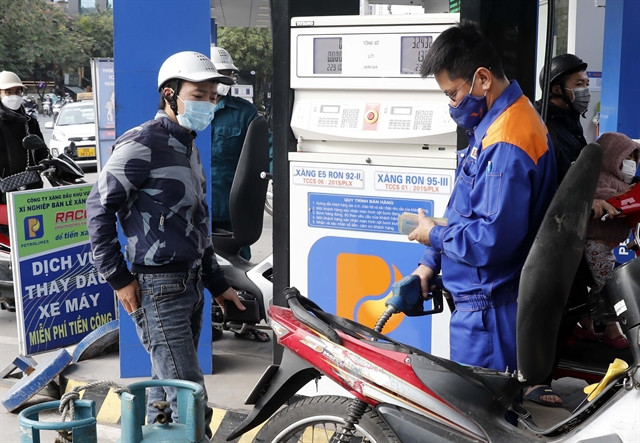 On February 11, the retail petrol prices increases by nearly 1,000 VND per litre, reaching the highest since August 2014. (Photo: VNA)
On February 11, the retail petrol prices increases by nearly 1,000 VND per litre, reaching the highest since August 2014. (Photo: VNA)OnFebruary 11, retail petrol prices were increased by nearly 1,000 VND perlitre following the latest adjustment by MoIT and the Ministry of Finance (MoF).
Theretail price of RON95 bio-fuel rose by 962 VND to a maximum of 25,322 VND (1.12USD) per litre, the highest since August 2014.
TranDuy Dong, Director of the MoIT’s Department of Domestic Market, told localmedia a few days after the rise that the increase should have been applied onthe first day of February but earlier at a Government’s meeting, MoF andMoIT pointed out that the petroleum prices had a great impact on theconsumer price index (CPI), which already rose by 1.94 percent in January andthe core inflation rate was 0.66 percent, so they delayed the rise.
Dongsaid: “The Government and ministries have to weigh the pros and consto ensure the interests of people and enterprises while ensuring macroeconomicstability.”
Hesaid if MoIT had raised petroleum prices earlier, the move would havefaced pressure from the public.
Mentioningthat some filling stations announced they had run out of petrol, MoIT’sleader affirmed that filling stations still had petrol, but are notselling because they were trying to hoard petrol, waiting for priceescalations.
Dongsaid: “Hoarding petrol for speculation, which causes shortages in somelocalities, distributors and sales agents will be strictly punished.”
Hesaid the MoIT minister had signed a decision to set up three inspectionteams that will visit some localities to inspect petrol supply.
MoIThas also sent a dispatch to localities, asking provincial people’s committeesto intensify inspections and monitor petroleum sales.
Dongsaid: “It’s necessary to share difficulties with petroleum enterprises as thesupply was disrupted when the Nghi Son Oil Refinery cut capacity. And importprices have escalated, causing losses for importers.”
Healso asked petrol enterprises to share difficulties with nearly 100 millionpeople and support the state’s efforts for macroeconomic stability.
Dongadded that enterprises have to observe regulations on inventories and sales,and must not hoard petroleum products for speculation, which affects supply.
TheMoIT leader said though the situation was better now than early February,the shortages in some localities still have not been resolved completely,partially because Nghi Son Oil Refinery was still running at 55 percent ofcapacity and imports had not arrived.
Thesupply in the market has become better, but some filling stations in somelocalities are still lacking petrol for sale, he said.
Becauseof geopolitical factors related to the conflict between Russia andUkraine, petroleum prices have been fluctuating heavily, affecting domesticprices, said Dong. “The supply will improve soon when more imports arrive.”
EconomistDinh Trong Thinh said that Vietnam's petrochemical projects met more than 70 percentof domestic demand.
Thinhsaid the state's petroleum reserves were still very low as “reservation ofpetroleum is a very difficult problem because the warehouse and wharf facilitiesare still modest and the state does not have enough large foreign currencysources to focus on petroleum imports.”
Thinhsaid petroleum reserves required strict requirements on geology, climate, fireand explosion prevention as well as issues related to security, politics andsociety so it was a matter of time for things to improve.
Whenthe petroleum reserve is large enough like many other countries in theworld, Vietnam will be able to proactively supply as well as intervenepromptly in all market fluctuations, he said.
Thinhconsidered monitoring and forecasting the trend of world gasoline prices achallenge in Vietnam.
Itis necessary to negotiate to buy and sell on terms of three months, sixmonths or one year so it was necessary to have data that gathersfactors such as supply, demand, and geopolitical impacts that could createadvantages or disadvantages.
Hesaid: “Currently, Vietnam is weak in both data sources as well ashuman resources in market analysis and forecasting,” urging the country tofocus on building them.
Asthe stabilisation fund can only intervene in the short term, in the long run, Vietnam shouldgradually build an open petroleum market in which local prices were closed tothe world petrol price and the time to adjust the petrol price should beshortened to five to seven days.
For MoIT, ifthe prices continue escalating and crude oil price surpasses 100 USD perbarrel, the director said it would be necessary to cut taxes and fees tostabilise prices, in addition to using the petrol price stabilisation fund.
Dongsaid: “If the prices are overly high, this will have the effect of neutralisingsome tools and policies being applied to help recover the economy, which hasbeen hit hard by COVID-19. This includes the policy on VAT reduction of 2 percent,”he said.
Someyears ago, MoIT proposed tax and fee reductions for petroleum, but the MoFrejected it saying tax revenue from the products made a big contribution to thestate budget./.





























